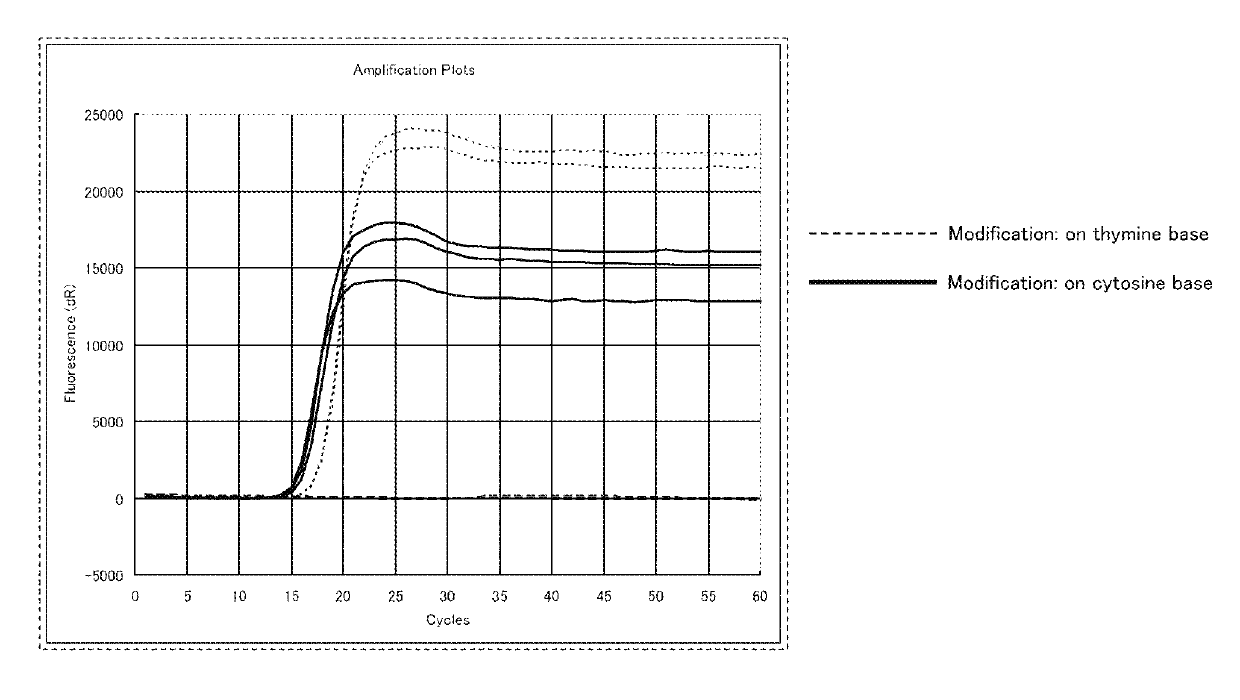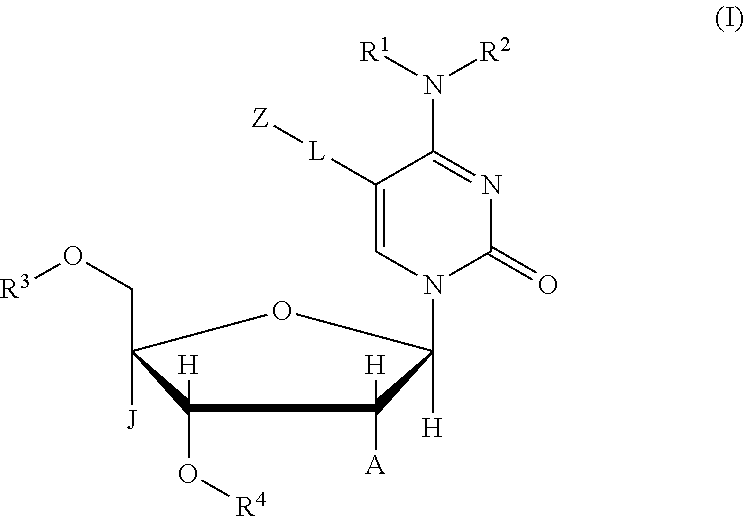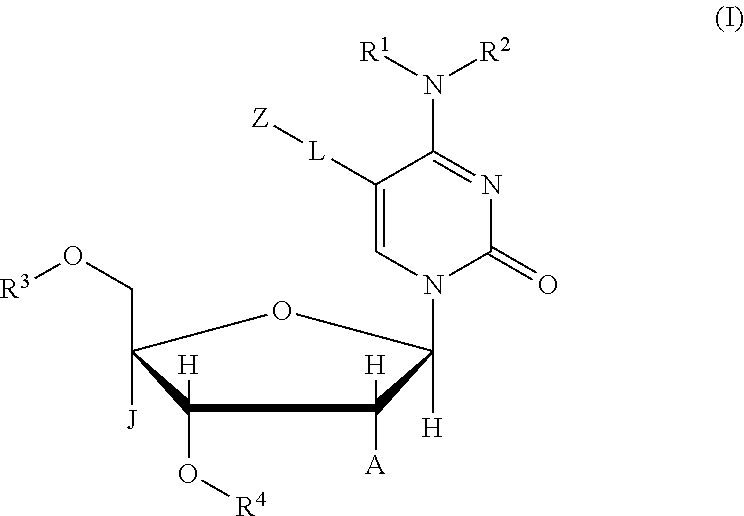Compound, nucleic acid, labeling substance, and detection method
a technology of nucleic acid and labeling substance, applied in the field of compound, nucleic acid, labeling substance, and detection method, to achieve the effect of reducing the restriction on sequence design
- Summary
- Abstract
- Description
- Claims
- Application Information
AI Technical Summary
Benefits of technology
Problems solved by technology
Method used
Image
Examples
example 1
[0284]According to the following Scheme 2, a nucleic acid derivative 4 (the compound of the present invention) represented by the following chemical formula 4 was synthesized from a nucleic acid derivative 2 (the following chemical formula 2).
[0285]
[0286]The nucleic acid derivative 2 (formula 2) as a raw material has already been reported (known) (document name: Tetrahedron Letters 2009, 50, 7191). Thus, the nucleic acid derivative 2 was synthesized with reference to the document. As a DNA synthesizer, an H-8 DNA synthesizer (NIHON TECHNO SERVICE CO., LTD.) was used. HPLC was carried out using an LC-20 series (Shimadzu Corporation). MALDI-TOF-MASS was carried out using a Microflex (Bruker Daltonics).
[0287](Synthesis of Nucleic Acid Derivative 3 (Formula 3))
[0288]The nucleic acid derivative 2 (1.31 g, 3.0 mmol) was added to a 300 ml Schlenk flask. After nitrogen substitution, 100 ml of dehydrated pyridine and 3.0 g of Molecular sieves 3A were added, and the resultant mixture was stir...
example 2
Synthesis of Modified DNA Oligomer
[0295]In the present example, an H-8 DNA synthesizer (trade name, NIHON TECHNO SERVICE CO., LTD.) was used as a DNA synthesizer, HPLC was carried out using an LC-20 series (trade name, Shimadzu Corporation), and MALDI-TOF-MASS was carried out using a Microflex (trade name, Bruker Daltonics).
[0296]First, as a raw material of a modified DNA oligomer, TO2-diamide (the compound represented by the chemical formula 5) was synthesized according to the following Scheme 3.
[0297]
[0298]In Scheme 3, Mono-N-Boc-diamine and TO used as raw materials are known compounds. Thus, they were synthesized with reference to methods that have already been reported. It is to be noted here that TO is the same as Compound 107 synthesized according to the above Scheme 1. In Scheme 3, the substituent “Boc” represents a tert-butoxycarbonyl group.
[0299]Synthesis of Mono-N-Boc-TO2-diamide
[0300]TO (0.763 g, 1.62 mmol), 7.0 ml of DMF, HOBt (0.243 g, 1.80 mmol), and HBTU (0.521 g, 1.6...
example 3
Performance of Modified DNA Oligomer in Isothermal Nucleic Acid Amplification Method
[0312]In a SmartAmp method (NATURE METHODS (2007), VOL. 4, NO. 3, p 257, Japanese Patent No. 3897805), which is a known isothermal nucleic acid amplification method, the performance of a DNA oligomer in which a thymine base was modified with a fluorescent dye (SEQ ID NO: 2 shown below) was compared with the performance of the DNA oligomer in which a cytidine base was modified with a fluorescent dye (SEQ ID NO: 1 shown above) (see FIG. 1). SEQ ID NO: 2 is the same as SEQ ID NO: 1, except that, instead of the cytidine base, the thymine base was modified with the fluorescent dye. In SEQ ID NO: 2, the lower-case letter “t” indicates the thymine base modified with the fluorescent dye. The thymine base modified with the fluorescent dye is represented by the following chemical formula 110.
[0313]
[0314]FIG. 1 shows the result of the nucleic acid amplification by the above-described SmartAmp method. As can be ...
PUM
| Property | Measurement | Unit |
|---|---|---|
| carbon number | aaaaa | aaaaa |
| chemical | aaaaa | aaaaa |
| tautomer | aaaaa | aaaaa |
Abstract
Description
Claims
Application Information
 Login to View More
Login to View More - R&D
- Intellectual Property
- Life Sciences
- Materials
- Tech Scout
- Unparalleled Data Quality
- Higher Quality Content
- 60% Fewer Hallucinations
Browse by: Latest US Patents, China's latest patents, Technical Efficacy Thesaurus, Application Domain, Technology Topic, Popular Technical Reports.
© 2025 PatSnap. All rights reserved.Legal|Privacy policy|Modern Slavery Act Transparency Statement|Sitemap|About US| Contact US: help@patsnap.com



